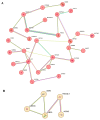Genetic Variant Analyses Identify Novel Candidate Autism Risk Genes from a Highly Consanguineous Cohort of 104 Families from Oman
- PMID: 39769462
- PMCID: PMC11679916
- DOI: 10.3390/ijms252413700
Genetic Variant Analyses Identify Novel Candidate Autism Risk Genes from a Highly Consanguineous Cohort of 104 Families from Oman
Abstract
Deficits in social communication, restricted interests, and repetitive behaviours are hallmarks of autism spectrum disorder (ASD). Despite high genetic heritability, the majority of clinically diagnosed ASD cases have unknown genetic origins. We performed genome sequencing on mothers, fathers, and affected individuals from 104 families with ASD in Oman, a Middle Eastern country underrepresented in international genetic studies. This approach identified 48 novel candidate genes significantly associated with ASD in Oman. In particular, 35 of these genes have been previously implicated in neurodevelopmental disorders (NDDs) in other populations, underscoring the conserved genetic basis of ASD across ethnicities. Genetic variants within these candidate genes that would impact the encoded protein included 1 insertion, 4 frameshift, 6 splicing, 12 nonsense, and 67 missense changes. Notably, 61% of the SNVs were homozygous, suggesting a prominent recessive genetic architecture for ASD in this unique population. The scarcity of genetic studies on ASD in the Arabian Peninsula has impeded the understanding of the unique genetic landscape of ASD in this region. These findings help bridge this knowledge gap and provide valuable insights into the complex genetic basis of ASD in Oman.
Keywords: autism spectrum disorder (ASD); candidate ASD risk genes; genome sequencing (GS); variant of unknown significance (VUS).
Conflict of interest statement
The authors declare no conflicts of interest.
Figures


Similar articles
-
Genome Sequencing Identifies 13 Novel Candidate Risk Genes for Autism Spectrum Disorder in a Qatari Cohort.Int J Mol Sci. 2024 Oct 27;25(21):11551. doi: 10.3390/ijms252111551. Int J Mol Sci. 2024. PMID: 39519104 Free PMC article.
-
Genomic architecture of autism spectrum disorder in Qatar: The BARAKA-Qatar Study.Genome Med. 2023 Oct 7;15(1):81. doi: 10.1186/s13073-023-01228-w. Genome Med. 2023. PMID: 37805537 Free PMC article.
-
Novel splicing variant and gonadal mosaicism in DYRK1A gene identified by whole-genome sequencing in multiplex autism spectrum disorder families.Neurogenetics. 2024 Oct;25(4):377-391. doi: 10.1007/s10048-024-00768-6. Epub 2024 Jul 8. Neurogenetics. 2024. PMID: 38976082
-
Biological implications of genetic variations in autism spectrum disorders from genomics studies.Biosci Rep. 2021 Jul 30;41(7):BSR20210593. doi: 10.1042/BSR20210593. Biosci Rep. 2021. PMID: 34240107 Free PMC article. Review.
-
Syndromic autism spectrum disorders: moving from a clinically defined to a molecularly defined approach.Dialogues Clin Neurosci. 2017 Dec;19(4):353-371. doi: 10.31887/DCNS.2017.19.4/sscherer. Dialogues Clin Neurosci. 2017. PMID: 29398931 Free PMC article. Review.
Cited by
-
Could a National Screening Program Reduce the Age of Diagnosis of Autism Spectrum Disorder?J Autism Dev Disord. 2025 Feb 28. doi: 10.1007/s10803-025-06770-7. Online ahead of print. J Autism Dev Disord. 2025. PMID: 40019620
-
Autism Spectrum Disorder, Oral Implications, and Oral Microbiota.Children (Basel). 2025 Mar 15;12(3):368. doi: 10.3390/children12030368. Children (Basel). 2025. PMID: 40150650 Free PMC article. Review.
References
MeSH terms
Grants and funding
LinkOut - more resources
Full Text Sources
Medical
Miscellaneous

